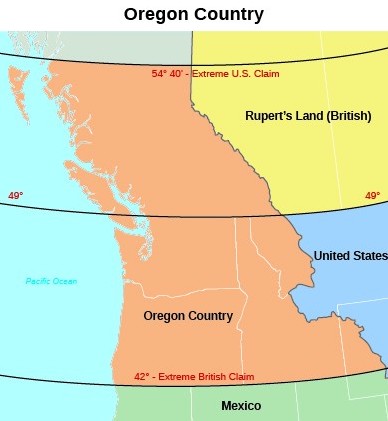James K. Polk and the Triumph of Expansion
A fervent belief in expansion gripped the United States in the 1840s. In 1845, a New York newspaper editor, John O’Sullivan, introduced the concept of “manifest destiny” to describe the popular idea of the special role of the United States in overspreading the continent—the divine right and duty of white Americans to seize and settle the American West, thus spreading Protestant, democratic values. In this climate of opinion, voters in 1844 elected James K. Polk, a slaveholder from Tennessee, because he vowed to annex Texas as a new slave state and take Oregon.
Annexing Oregon was an important objective for U.S. foreign policy because it appeared to be an area rich in commercial possibilities. Northerners favored U.S. control of Oregon because ports in the Pacific Northwest would be gateways for trade with Asia. Southerners hoped that, in exchange for their support of expansion into the northwest, northerners would not oppose plans for expansion into the southwest.

President Polk—whose campaign slogan in 1844 had been “Fifty-four forty or fight!”—asserted the United States’ right to gain full control of what was known as Oregon Country, from its southern border at 42° latitude (the current boundary with California) to its northern border at 54° 40′ latitude. According to an 1818 agreement, Great Britain and the United States held joint ownership of this territory, but the 1827 Treaty of Joint Occupation opened the land to settlement by both countries. Realizing that the British were not willing to cede all claims to the territory, Polk proposed the land be divided at 49° latitude (the current border between Washington and Canada). The British, however, denied U.S. claims to land north of the Columbia River (Oregon’s current northern border). Indeed, the British foreign secretary refused even to relay Polk’s proposal to London. However, reports of the difficulty Great Britain would face defending Oregon in the event of a U.S. attack, combined with concerns over affairs at home and elsewhere in its empire, quickly changed the minds of the British, and in June 1846, Queen Victoria’s government agreed to a division at the forty-ninth parallel.
In contrast to the diplomatic solution with Great Britain over Oregon, when it came to Mexico, Polk and the American people proved willing to use force to wrest more land for the United States. In keeping with voters’ expectations, President Polk set his sights on the Mexican state of California. After the mistaken capture of Monterey, negotiations about purchasing the port of San Francisco from Mexico broke off until September 1845. Then, following a revolt in California that left it divided in two, Polk attempted to purchase Upper California and New Mexico as well. These efforts went nowhere. The Mexican government, angered by U.S. actions, refused to recognize the independence of Texas.
Finally, after nearly a decade of public clamoring for the annexation of Texas, in December 1845 Polk officially agreed to the annexation of the former Mexican state, making the Lone Star Republic an additional slave state. Incensed that the United States had annexed Texas, however, the Mexican government refused to discuss the matter of selling land to the United States. Indeed, Mexico refused even to acknowledge Polk’s emissary, John Slidell, who had been sent to Mexico City to negotiate. Not to be deterred, Polk encouraged Thomas O. Larkin, the U.S. consul in Monterey, to assist any American settlers and any Californios, the Mexican residents of the state, who wished to proclaim their independence from Mexico. By the end of 1845, having broken diplomatic ties with the United States over Texas and having grown alarmed by American actions in California, the Mexican government warily anticipated the next move. It did not have long to wait.